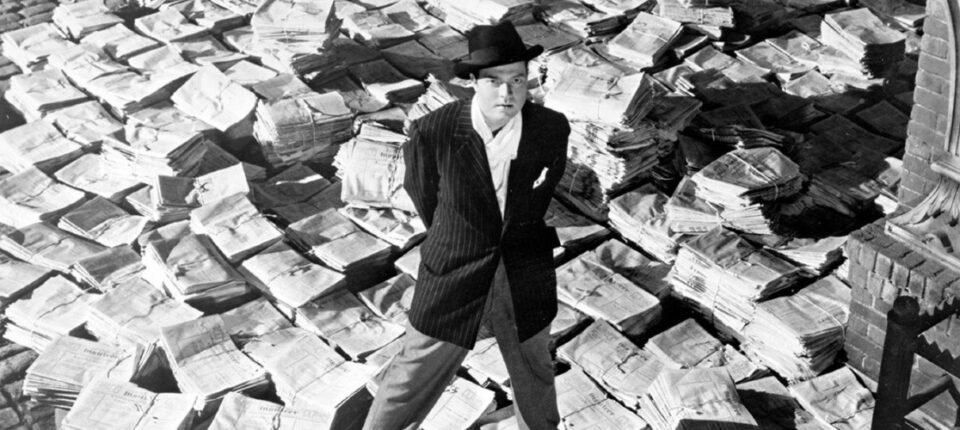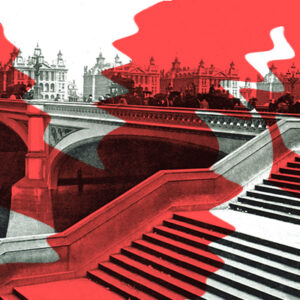In an early scene in the first episode of “Slow Horses,” the British spy thriller series streaming on Apple TV+, a stack of newspapers is delivered to the run-down Slough House office of MI5, the British intelligence agency. The print papers seem as obsolete as the cast-off, screw-up agents who have been sentenced to this out-of-favor outpost by author Mick Herron, who wrote the books the series is based on.
The agents couldn’t have cared less about the newspapers. On the other hand, I was thrilled.
As a longtime newspaper reporter and editor, who started writing for Indiana newspapers when I was in high school, there’s something about seeing print newspapers figure, in ways large and small, into the narratives of fiction. I love spotting shots of print papers in movies and TV.
“Slow Horses” almost certainly meant to echo the out-of-the-mainstream status of Slough House with the prominent delivery of the dead tree editions of the news. But it prompted me to think about the role print newspapers have played in my life and our popular culture. There’s the movie device of spinning front-page headlines that’s been used in dramas and comedies. And almost everyone understands what the newspaper printing and sorting process looks like, with copy after copy of the latest edition running through pressroom machinery around, up and down and overhead, just waiting for someone to yell, “Stop the presses!”
In movies and TV shows set in the past, when old-timey telephones – rotary phones, phones hanging on a wall, those in a phonebooth – appear on screen, it’s an easy joke in my household to facetiously exclaim, “What are those things?”
It’s my newspaper background that has me feeling nostalgic when I spot a print newspaper, however. I don’t shout out “WHAT IS THAT?” in mock tones of confusion, even though for years now I haven’t gotten delivery of the print edition of the newspapers I subscribe to.
Instead, when I see those print newspapers, I feel warmly nostalgic for something that was part of my life years before I wrote.
Clippings of the Planet of the Apes
When I was a kid in the 1960s and 1970s, I was already a movie fan – a growing-up period previously recounted for CrimeReads – and turned for my fix to one of the two daily newspapers my parents subscribed to.
A budding journalist even then – although I wouldn’t know it for a few more years – I cut from newspapers articles and interviews and movie reviews and pasted them in construction-paper scrapbooks, emulating magazines like Famous Monsters of Filmland.
A big part of my obsession with the intersection of movies and newspapers was the movie theater ads in newspapers back then, in the 1960s and 1970s. I still remember going to the drugstore and buying a real big-city newspaper on Fridays because of the huge ads for films like “2001: A Space Odyssey.” I still have, buried somewhere, one of my few remaining scrapbooks and an ad I clipped out for an all-night drive-in marathon of all five “Planet of the Apes” movies. (I went to that “Ape-athon,” too.)
Based on the number of nostalgia groups I see on Facebook reposting old newspaper ads, I wasn’t alone in my interest. But the clipping of newspaper articles and ads isn’t something that carries over into screenshots of printouts of modern-day news stories. Because there’s something magical about print, and I think it’s a holdover from the days when print was the way we got our news – or at least it was the only way that counted. Or perhaps it is the most photogenic way for modern-day filmmakers to pluck our nostalgia.
It was probably in more than one episode of “The West Wing” that the wily but likable Washington Post reporter Danny Concannon had broken some big story and Sam and Josh huddled in a hallway, worried about the repercussions on President Jed Bartlet when the story came out. The president’s loyal staff took solace in the fact that the latest edition of WaPo hadn’t been printed yet; the story was only online so far, so few people had seen it, they reasoned. Of course, things are now reversed.
It would be folly to try to cite all the great film and TV placements of newspapers and 72-point newspaper headlines; there are just too many, and there are plenty of articles and social media accounts that do so.
But a few:
The dueling headlines prepared for “Citizen Kane” and the election run of newspaper mogul Charles Foster Kane are very nearly the pinnacle of such uses and are terrifyingly prescient, as two headlines are prepared for the first edition in print after election results are known: KANE ELECTED or FRAUD AT POLLS. That tactic sounds strangely familiar today.
That was an example of the “either or” headlines that played into other films, including stories of the end of the world – or not, as signaled by the front-page headline chosen.
WHERE IS THE MERRY WIDOW MURDERER? asks a headline in Alfred Hitchcock’s “Shadow of a Doubt,” an unduly overlooked masterpiece. The headline propels the plot, as Uncle Charlie (Joseph Cotton) scrambles to hide newspapers from his family but can’t outsmart his niece and namesake Charlie (Teresa Wright).
Probably the funniest use of a print newspaper front page came in 1981’s “The Great Muppet Caper,” which announces, IDENTICAL TWINS JOIN CHRONICLE STAFF. The surface level joke is that Kermit and Fozzie don’t look like identical twins, but below the surface lies a great joke about how self-obsessed and self-referential newspapers are about their staffs.
But it’s the look of print newspapers and the role they play in our lives and movies that fascinates.
Bad news on the doorstep
This year, I binged “The Crown” for the first time in preparation for watching the final season and was struck by the presence of print newspapers throughout the history of Elizabeth’s reign. The Windsors certainly tuned in radio and TV at times, notably the Apollo moon landing. But to my eye, the daily delivery of British newspapers – in print, and even after news became available online – was the most notable signal of how Elizabeth and the family consumed news, including the latest, often unflattering portrayals and public opinion of the royal family.
On quite another level, the newspapers where I worked, first The Muncie Evening Press and later The Star Press, also broke a lot of bad news: murder, malfeasance and political scandal.
Nowhere was our news consumed more avidly than in local government offices of the mayors, judges and officials we covered. For quite a few years, reporters delivered, twice a day, free copies of the two newspapers to the local government offices, where they were eagerly consumed. The practice, which came to an end even before all news went online, not only informed our sources but gave us a deft entry to those offices.
For decades – a couple of them during my time – the newspapers were printed locally, on presses operated by skilled workers who, on their lunch hour, sat in their cars in a parking lot across the street and drank. We sometimes wondered how some of these folks didn’t lose any fingers in the machinery after they drank their lunch. But they were professionals, shrugging off the dangers of tons of equipment running at high speed. Not that they wouldn’t have ducked into the covered escape hatch at one end of the pressroom if those huge presses decided to blow apart.
Being in the same building complex as the presses where our newspapers were printed gave all of us, for a time, the opportunity to pick up the print product while it was still fresh and the ink would be smudged by our fingers. It was heaven for a print fan.
All these years later, my only regret is that I never got to rush in and shout, “Stop the presses!”

















